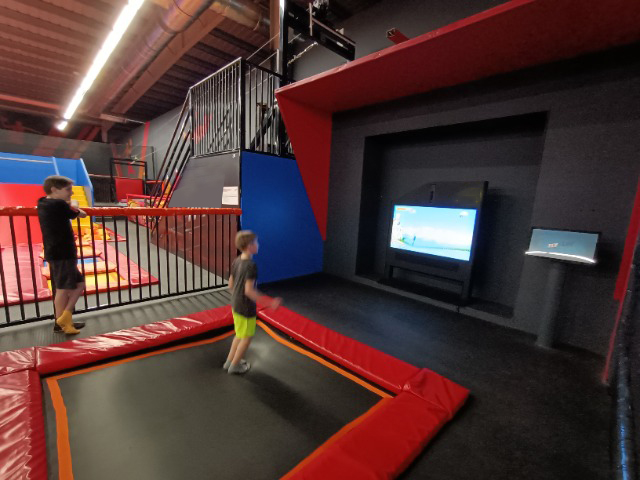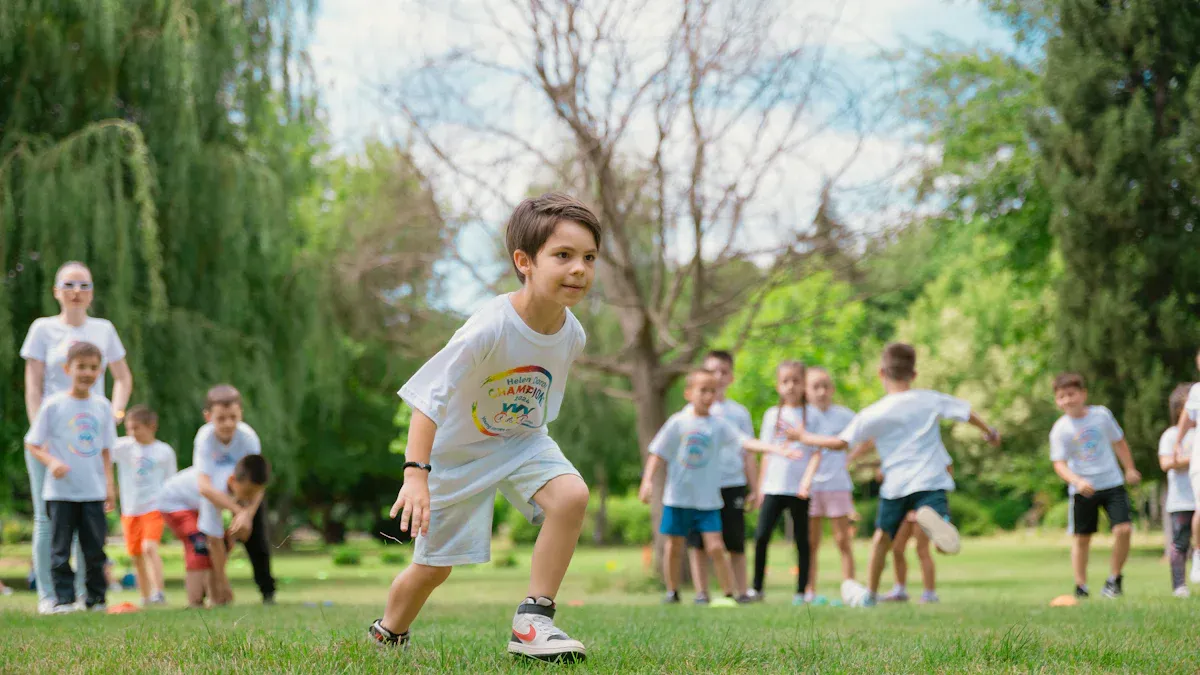Why indoor trampolines are essential for children’s healthy growth

You want your kids to be strong and confident. You also want them to have lots of energy. Picking a childrens indoor trampoline helps their health. It also makes playtime more fun. Jumping on a trampoline helps the heart and helps kids grow. Research shows this is true. Look at these findings:
| Evidence Description | Key Findings |
|---|---|
| Trampoline jumping improves cardiopulmonary function in children | Good for health and growth |
| Achieves high intensities suitable for HIIT | Helps kids be more active |
| Enjoyable activity for children | Kids want to play more often |
Why do families choose indoor trampolines?
- You get a safe place for kids to play.
- Kids can move even if they cannot go outside.
- Softer parts and lower jumps make it safer for little kids.
- Small trampolines fit in playrooms or basements.
Key Takeaways
- Indoor trampolines help the heart stay healthy. They give a fun and easy workout. This workout makes the heart stronger.
- Jumping on a trampoline makes muscles stronger. It also helps kids move better. Kids build a strong core and stand up straighter.
- Trampolining helps kids feel better. It lowers stress and builds confidence. Kids learn new skills while jumping.
- Playing on trampolines with others builds social skills. Kids learn to work as a team. They also learn patience and how to talk to each other. They have fun together.
- Safety is very important! Always watch kids on the trampoline. Make sure it is set up right. Follow safety rules to keep kids safe while they play.
Physical Benefits

Cardiovascular Health
You want your kids to be healthy and active. Trampolining gives a strong heart workout. It does not hurt their joints much. Jumping on a trampoline gets the heart pumping. It is as good as running, but safer for kids. Here are some reasons why childrens indoor trampoline use helps the heart:
- Trampolining gives a hard heart workout with less joint stress than running.
- Kids use oxygen better when jumping than when running on a treadmill.
- Jumping on a trampoline is over 85% easier on joints than running.
If you look at the numbers, you see trampolines give a real workout. Check out this table:
| Measure | Value |
|---|---|
| Mean heart rate during training | 164±13 min-1 |
| Percentage of HRmax | 83±4% |
| Energy expenditure | 9.7±2.5 kcal/min |
| Perceived exertion (BORG scale) | Decreased from 16.6 to 13.7 over 24 sessions |
Kids can play and exercise at the same time. They get healthier hearts and burn off energy. You do not have to worry about hard impacts. They build endurance and feel more energetic every day.
Muscle & Core Strength
Trampolining is more than just bouncing. When kids jump, they use many muscles. Their legs, glutes, and core all work together. Regular trampoline use makes muscles stronger and posture better.
- Jumping uses leg muscles like calves, hamstrings, quadriceps, and glutes.
- It also works the stomach and back muscles to keep balance.
- Trampoline workouts use core, legs, and stabilizer muscles. They burn more calories than jogging.
- Jumping uses the whole body’s movement. It works abs, glutes, legs, and back. This builds a strong core.
Trampolining burns more calories than running. It is easier on joints. It is a full-body workout. Kids can manage weight and build strong bones. Doctors say muscle and bone exercises are important for kids. They suggest three days a week of muscle-strengthening activities.
| Benefit Type | Description |
|---|---|
| Cardiovascular Workouts | Jumping is an aerobic exercise that raises heart rate and burns calories. |
| Muscle Engagement | Engages multiple muscle groups including glutes, legs, upper body, and core. |
| Balance Improvement | Helps improve balance and coordination, especially beneficial for children and older adults. |
| Joint Safety | Provides a low-impact workout that is easier on the joints compared to other high-impact exercises. |
Kids get stronger, stand taller, and feel more confident. They play and exercise on their childrens indoor trampoline.
Balance & Coordination
Balance and coordination are important for growing kids. Trampolining helps them learn these skills in a fun way. When kids jump, they learn to control their bodies. They adjust their moves and stay upright on a moving surface. This helps with everyday activities.
A 12-week trampoline program showed big gains in balance and coordination. This was true for kids with Developmental Coordination Disorder too. The trampoline’s moving surface gives special sensory feedback. This helps kids get better at balance and coordination.
Trampolining uses stabilizer muscles. This helps posture. It also makes bones stronger, especially at the spine and hip. Kids who use trampolines often have better coordination, stronger bones, and better posture.
Pediatricians say, “Any home use of trampolines is considered dangerous and is strongly discouraged,” but with proper safety steps, childrens indoor trampoline use can give many physical benefits.
When you pick trampoline activities, kids build balance, coordination, and strength. They have fun and grow healthier and more confident each day.
Mental & Emotional Growth
Confidence Building
You want your kids to feel good about themselves. When they learn new trampoline skills, their confidence grows. Each time your child does a new jump or trick, they feel proud. They know they can do hard things. This helps them try new activities. Trampolining is not just fun. It helps kids believe in themselves. They learn by practicing and getting better. After a good session, your child stands taller and smiles more. Kids love to show what they can do on a childrens indoor trampoline. You can see their confidence rise with every bounce.
Tip: Celebrate small wins! Give your child a high-five or cheer when they learn something new. This helps their confidence grow even more.
Stress Relief
Kids get stressed too, even if it is not like adults. Trampolining is a healthy way for them to let out stress. When your child jumps, their body makes endorphins. These chemicals help them feel better and less upset. This is great for kids with ADHD or who need help focusing. Jumping often lowers cortisol, which is the stress hormone. It helps kids feel calm and relaxed.
Here is how trampolining helps with stress:
- Endorphins make kids happier and less upset.
- Bouncing lowers stress hormones and helps kids feel calm.
- Jumping boosts dopamine and serotonin, which help mood and focus.
- Kids burn off extra energy and handle emotions better.
- Trampolining helps kids deal with anger, worry, or too much energy.
- It gives kids energy for the day or helps them relax after school.
Trampolining is more than just exercise. It helps kids feel better inside. You give your child a safe place to play and grow. With each bounce, they get more confident and less stressed.
Developmental & Social Skills

Imaginative Play
Kids love to make up stories and games. A trampoline can become a magical place with imagination. When kids bounce, they might pretend to fly in space or jump on clouds. This kind of play helps them be creative and show their feelings. Trampolining gives a safe spot to dream and act out adventures.
- Kids pretend to be superheroes or animals.
- Trampolining helps them know their bodies and control feelings.
- Bouncing helps big movements, balance, and coordination.
- Playing with others on a childrens indoor trampoline builds teamwork and friendships.
You can join your child and make up games together. You might count jumps or make silly challenges. These activities keep kids active and learning while having fun. Every bounce is a new chance to grow and discover.
Social Interaction
Trampolining is not just for one person. When kids jump together, they learn social skills. They take turns, cheer for friends, and make up group games. These moments help kids learn patience, kindness, and confidence.
| Evidence | Description |
|---|---|
| Indoor playgrounds help kids interact | They give chances for teamwork and talking with others. |
| Trampoline activities teach social skills | Kids learn patience, confidence, and kindness while playing. |
You might see your child wait for a turn or help a friend try something new. These actions teach teamwork and respect. Jumping in groups also helps kids talk and share ideas. They discuss rules, share thoughts, and solve problems together.
- Moving helps kids feel better and make friends.
- Group trampolining teaches teamwork and bouncing back from mistakes.
- These times can lower worry and make kids happier, so they talk and connect more.
When you support group trampolining, your child learns to be a good friend. They see that play is not just exercise—it is about sharing, talking, and learning together. With every bounce, kids build skills for life, like working with others and talking well.
Childrens Indoor Trampoline Safety
Safe Indoor Activity
You want your kids to stay active, even when the weather keeps you indoors. Trampolining gives you a safe way to keep them moving. Indoor trampolines let your family enjoy exercise all year. You do not have to worry about rain, snow, or strong sun. You control the space and the rules.
Trampolining at home can be safer than outdoor or park trampolines. You can set up a safety enclosure and watch your kids closely. Most injuries happen when more than one child jumps at the same time or when kids try risky moves. Younger children, especially those under six, face a higher risk of falls and injuries. Older kids may get hurt from dangerous tricks. Here are some facts to keep in mind:
- Most trampoline injuries happen to children ages 5-15.
- Small children are 14 times more likely to get hurt than bigger kids.
- 75% of injuries occur when several children jump together.
- The majority of injuries in kids under 12 come from falls or missteps.
You can lower these risks. Always supervise your kids. Let only one child jump at a time. Keep the trampoline on level ground and check it for hazards. Remind your kids to jump in the center and avoid flips or rough play.
Tip: Make a simple rule chart and hang it near the trampoline. This helps everyone remember how to stay safe and have fun.
For All Ages & Abilities
Trampolining can fit many ages and skill levels. You just need to pick the right trampoline and follow safety steps. Children under six should not use trampolines. For kids ages 6-10, choose a trampoline between 6 and 12 feet wide. Preteens and teens need a larger trampoline, at least 12 feet across.
Here are some ways to keep trampolining safe for everyone:
- Always use a safety enclosure.
- Leave 3-5 feet of space around the trampoline.
- Check the trampoline every day for loose springs or tears.
- Clean the mat with a soft brush and gentle soap.
- Replace worn parts right away.
- Keep a maintenance log to track repairs.
You can help your kids enjoy trampolining as a safe exercise. When you follow these steps, you give them a place to build strength, balance, and confidence. Trampolining brings fun and movement to your home, no matter the weather.
You want your child to grow strong, happy, and confident. Indoor trampolines help with heart health, muscle strength, and better mood. Kids learn teamwork, focus, and problem-solving while they play. When you choose a trampoline, look for safety nets, padding, and the right size for your child. Check the weight limit and leave space around the trampoline.
| Benefit Type | Description |
|---|---|
| Cardiovascular Health | Jumping improves heart and lung strength. |
| Motor Skills | Kids boost coordination and muscle control. |
| Bone Strength | Exercise builds strong bones. |
| Mental Health | Play lifts mood and lowers stress. |
| Social Skills | Group play teaches teamwork and sharing. |
Active play today builds healthy habits for life. Give your child the gift of movement and fun! 🎉
FAQ
How much space do I need for an indoor trampoline?
You need at least 3 to 5 feet of clear space around the trampoline. Make sure nothing blocks the area. This keeps your child safe while jumping.
Can my child use the trampoline every day?
Yes! Daily use is great for energy and health. Just watch your child and make sure they follow safety rules. Short, regular sessions work best.
What age is best for starting on a trampoline?
Most experts say age 6 and up is safest. Younger kids can get hurt more easily. Always check the manufacturer’s age guidelines before you buy.
How do I keep the trampoline clean and safe?
Wipe the mat with mild soap and water. Check for loose springs or tears each week. Replace worn parts right away. A quick check keeps things safe and fun! 🧼
